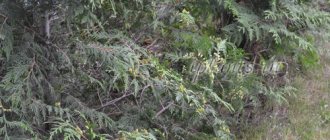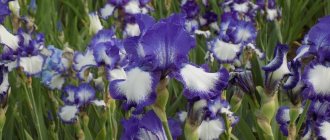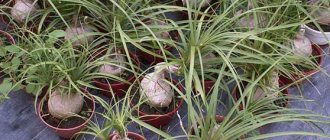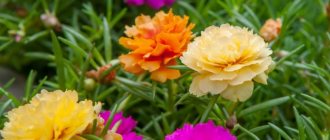Home » Flowers and plants » Flowers » Annual flowers
Olga Polyakova 03/19/2020
3216 Views
Poppy is a herbaceous plant belonging to the Poppy family. Its distribution is very widespread - poppy is found everywhere in the tropics and temperate climates. Some poppy species also thrive in colder areas. The unpretentious flower prefers to grow in dry places; Most often poppies are found in steppes and semi-deserts; they also love dry foothills. Poppy is mainly used as an ornamental plant. In addition, it is used in the food industry for the production of confectionery and margarine. The plant is very unpretentious, so planting poppies and caring for them is not particularly difficult for gardeners.
Variety "Kerlilock"
With slightly drooping flowers and a thin stem, this poppy resembles a sad piece of nature. Its traditionally orange (there are also red, yellow and even pink) petals with black spots closer to the base look incredibly touching.
Variety "Princess Alexandra and the Little Dancer"
These varieties, like their names, are incredibly delicate and light. Having a pink flower and the finest petals, their diameter does not exceed 15 cm, and they bloom in the very middle of summer. The varieties Ruffled Patty, Miss Piggy and Patty's Plum also boast lilac color
Variety "Diamond"
This is a bright representative of the group of red poppies, so named because it is truly a collective image of a flower that has formed in the world over many millennia. Among those with a red and scarlet hue, the varieties Marcus Perry, King Kong, Turkenlouise and others also stand out.
Opium poppy (Papaver somniferun)
It is also called “soporific poppy” and is not visible in reality, since it is also prohibited for cultivation. It blooms profusely and incredibly spectacularly in June – July. In the early morning the flowers open, and at sunset they fall. Such an everyday process resembles smooth breathing or a plastic sketch of the constant movement of a stem and flower, shown in rapid motion. You can watch this process for hours.
Application
- The taste of poppy seeds is used in cooking. It is added to sauces, sprinkled on baked goods and confectionery products, increasing the nutritional value of products. Poppy oil is also used in cooking.
- In medicine, poppy is used as a sleeping pill; it contains morphine, codeine, and papaverine. Morphine has analgesic properties. Codeine calms severe coughs. Papaverine relieves spasms of arteries, muscles, and bronchi.
- In folk medicine, self-seeding is used, infusions and decoctions are made, and diarrhea, dysentery, and bladder diseases are treated.
- Milk of the poppy is used by supporters of proper nutrition and vegetarians.
- Essential oils are used in cosmetology. Due to the presence of stearic, oleic, linoleic acids, vitamin E, codeine, morphine and papaverine, the oils are ideal for the production of cosmetic anti-aging and moisturizing products.
Variety "Black Cloud"
A blue-black or dark purple flower on a silver-green stem, with leaves shimmering under the moon - this is how you can see this variety of poppy.
Variety "Danish flag"
Already from the name it is clear that the variety got its name from its resemblance to the flag of Denmark - on the red canvas of the petals you can see a white and cream cross, which in the wind, as if a flag is developing, showing sharp corners and slightly jagged edges.
Variety "Merry Family"
For those who lack imagination, it is quite difficult to imagine a flower whose petals and its seed pod resemble a hen with chicks. However, this is exactly what this variety looks like. Due to their amazing color, such flowers are often used in making winter arrangements or even bouquets.
Peony varieties
Yellow, black or white cloud, Zverg Rosenrot or Tsartrosa are all names of varieties of opium poppy. Each of them is beautiful in a special way, because it has its own, pure and rich color scheme.
Subfamilies
The Poppy family is divided into two subfamilies. The main criterion for classifying genera is the structure of the flower. So, for example, celandine and poppy have a regular shape and belong to the subfamily Poppyaceae proper, and representatives with a zygomorphic form belong to the Dymyankovs. Let's look at the second one in more detail. The largest genus of Dymyankovs, Corydalis, includes about 300 species. All of them grow in the temperate climate of Eurasia and North America. Many of them are geophytes, having tubers (mostly of root origin), and ephemeroids. In particular, the familiar corydalis is one of these. A plant with large clusters of purple-pink flowers, which are especially loved by bumblebees. They are sharply zygomorphic in shape. The reason for this is the petal of the outer circle, elongated into a spur. But if you compare the diagrams of corydalis and aconite, you will notice completely different types of zygomorphy - in the first it is transverse. Only flowers of the poppy family have similar features.
Samosa poppy (Papaver rhoeas)
Most common in the Caucasus and Western Siberia, this type of poppy has flowers of all shades of red and is also called “field poppy.” Growing up to 80 cm in height, the plant has large flowers that are used to color wines and various syrups. Although this plant, like most of its species, is poisonous, its seeds are used in baking.
Benefit
The benefit of poppy lies in the content of vitamins, microelements, and minerals that have a beneficial effect on the human body. Calcium minerals are positively and easily absorbed. The seeds of this plant are used in the preparation of infusions, which are taken for nervous diseases, for restful sleep, to relieve fatigue, and for convulsive coughs.
Poppy is also an anthelmintic and is useful for diarrhea. Poppy products are used in cosmetology, and milk of poppy is a food for vegetarians. In addition, poppy seeds are high in calories.
Variety "Silk Moire"
Semi-double red flowers have muted shades, just like the leaves, which become slightly lighter from the edge to the center.
Variety "Shirley"
We are used to seeing a black core in poppies, but this variety is an exception - among the simple, brightly colored double flowers, you can see a white center, giving the flower an incredibly festive look. Perhaps it is not like other poppies, since it was brought back in the 19th century from England, where it still grows.
Vegetative methods of propagation
In fact, these methods are indirect consequences of the rejuvenation of overly dense poppy thickets, which are threatened with death from excessive crowding. This method of propagation is, rather, a forced measure, since even perennial poppy has a negative attitude towards any form of transplantation.
Preparation of root cuttings
However, it is recommended to dig up perennial poppies from the ground every 3-4 years and separate their rhizomes. Although, the term “separate” is hardly appropriate here - we are talking about separating side shoots and stem rosettes.
The children obtained in this way are seated in new places, where it is relatively difficult to take root. Difficulties may manifest themselves in the length of time it takes to adapt to new conditions, a decrease in growth rates, diseases and other negative phenomena. But, in any case, this is also a propagation method and for perennials it is faster than growing them from seeds.
Another alternative to seeds is to use cuttings. Root cuttings are obtained from the stubble part of the plant root, their length ranges from 4 to 6 cm, and the minimum thickness must be at least 5 mm.
Green poppy cuttings
Both cuts of the cutting are treated with crushed charcoal and planted in the ground for germination. When planting, the cuttings are buried 2.5-4 cm into the ground. They are watered with water and covered with improvised greenhouses made from cut plastic bottles. After about 3-4 weeks, the cuttings take root and leaves appear. After this, they can be transplanted to a new location.
Another cutting method uses green cuttings . As a rule, they are made from weak lateral shoots, on which flowers may not appear at all. Typically, such shoots form after flowering has ended, and their appearance lasts until the end of summer.
The length of green cuttings is also from 4 to 6 cm . However, their germination and rooting is carried out not in the garden bed, but in a peat substrate. Green cuttings are germinated in the same way as root cuttings (with the same depth and mini-greenhouse). Their rooting time is the same. After rooting, they are planted in open ground. For the winter, young seedlings are covered with a 10 cm layer of mulch from any available material.
California poppy
An incredibly beautiful type of poppy, but a little breaking the stereotypical idea of this flower. The shape of the petals resembles a kind of vessel, expanding upward, and the color, as a rule, is always orange, for which the poppy is nicknamed the “golden cup”. They bloom until late autumn, so they fit perfectly into rainy season landscapes. These flowers are often used to decorate borders or sidewalks, and when combined with lavender or cornflowers, they create beautiful compositions in flower beds.
Flower care
Caring for poppy is quite easy; even a child can handle it. The plant does not need to be watered often, nor does it need to be fertilized or fed. It is enough to clear the soil of weeds and sprinkle its top layer with mulch. Poppy is practically immune to various diseases, but sometimes they can occur if not properly cared for. This:
- powdery mildew;
- Alternaria blight;
- fusarium;
- peronosporosis.
The fungus can infect the leaves, causing a white coating to appear on them. It gradually disappears, but black or red spots remain on the plant. Powdery mildew slows down the growth and flowering of poppies. But you can get rid of it: you need to mix 40 g of soda and 10 liters of water, spray the bushes with this solution.
Poppy can also suffer from fusarium blight. Because of this disease, the leaves and heads may become covered with black spots. The plant gradually dries out, the boxes do not develop and become brown. The disease affects the vascular system and spreads throughout the entire body of the bush. Such a plant cannot be cured; it must be removed from the flowerbed and destroyed, and the area around it treated with an antifungal solution.
Alternaria blight is a type of fungus that attacks the leaves of a flower. Yellow spots appear on them, and you can get rid of them with the help of a fungicide. Curvature of shoots and peduncles develops due to peronosporosis. A gray coating appears on the underside of the leaves; because of this disease, the poppy will have much fewer seeds in the box. In this case, it is necessary to treat the plant with a solution of soda and water.
All diseases can be prevented. Experts do not recommend planting annual plants in the same place every year. It is better to destroy any remnants of them and look for new flower beds for them.
Poppy can also be harmed by some insects. Small weevils infect the roots of the plant, and its larvae eat the leaves. And you can get rid of this pest with the help of chlorophos. Sometimes aphids appear on poppies. It can be eliminated by spraying the bush with a soap solution or a decoction of ash.
Blue poppy (Himalayan poppy)
Tibetan, bell, blue - these are all flowers that came from the Himalayan mountains. Growing there, they spread over many kilometers, resembling an azure lake from afar. However, it is unlikely that you will be able to see such landscapes, since they grow at an altitude of about 3000 m. But what about growing them yourself, many will ask. Anything is possible, but only for those who are not afraid to wait and know how to work - the process of growing such poppies is quite complicated.
Main conclusions
Friends, it seems to me that garden poppy is necessary on the plot. Once you plant one flower, you will want to look for other species and varieties. After all, they bring a lot of beauty to the garden, but require very little from us.
These flowers are suitable for any place with treated soil in the sun or even in partial shade. The main thing is that the place is not damp, so these are dry-loving plants. Compost, sand and ash are added to the soil mixture for planting, but this is not at all necessary.
In my garden, perennial garden poppies have been growing for about 15 years in ordinary loamy soil and do not require anything from me. Every year they bloom and bring us a lot of happiness. So plant garden poppies - they will not let you down! That's all I have for today. Natalya was with you.
How do you feel about poppies in the garden? Do you like these flowers or prefer others? Share your thoughts in the comments.
Hollow poppy (Papaver nudicaule)
This perennial plant is a typical type of poppy with an orange-red color scheme. Growing up to 50 cm in height, the flowers, due to their thinness and ease of use in floral arrangements, are sometimes cut for bouquets. It is interesting that this species is also called Icelandic or Arctic, all because the stems are so thin and the leaves have a gray-green color that it seems as if the flower grew in the cold, and the greenery that appears from the presence of a sufficient amount of sunny color is absolutely alien to it . According to another version, it is called “saffron”, and Eastern Siberia is considered its homeland.
Variety "Atlant"
A perennial variety of poppies with single flowers of yellow or white color, growing on thin stems (20 cm) and having small flowers (5 cm). It is quite frost-resistant, so it is often cut for bouquets, but it is worth remembering that the juice can clog blood vessels, so carefully cut it and hold it over the fire.
Use in cosmetology
Red flower seeds are also beneficial for skin health. Thanks to linoleic acid, this product is important for the treatment of eczema, itching, burning and inflammation of the skin. To do this, use poppy seeds, previously soaked in milk or water and ground into a paste. To enhance the healing effect, some add lime juice. This product moisturizes well, smoothes the skin, and makes it soft. By mixing poppy seeds with cottage cheese, you can prepare an excellent facial scrub.
These small grains are also useful for hair. In particular, for getting rid of dandruff, treating split ends and thinning hair. A mixture of cottage cheese, soaked seeds and white pepper, applied to the scalp and left for half an hour, will help against dandruff. A mixture of poppy seeds and coconut water (the seeds are infused in it) is a means of stimulating hair growth.
Poppy "Alpine"
The shortest type of poppy, but at the same time blooming early. It begins to delight with its white-yellow flowers in May, and stops in June. Therefore, you should hurry to see the amazing combination of the most delicate shades of these colors, among which there are also reflections of pink and orange. We also note that the white color of the petals often has a blue tint, so these flowers look incredibly beautiful in combination with cornflowers.
Perennial species
Some types of poppies are distinguished by their extraordinary vitality, and, one might say, are ineradicable, thanks to the ability to throw out shoots from pieces of roots remaining in the soil after weeding. These are perennial poppies; their most obvious representatives are the rock poppy and the Atlantic poppy, which are similar to each other. The oriental poppy, a perennial poppy species with exceptional decorative properties, has gained great popularity.
poppy
Most gardeners are unfamiliar with poppy (Papaver rupifragum), also called Spanish poppy. This is a low plant with a chic rosette of silver-colored leaves located in the root zone, which in themselves look very elegant and rich. Its semi-double flowers have satiny petals in a unique orange hue. It blooms profusely throughout the summer with small flowers no more than 2.5 cm in diameter.
Among the interesting varieties of poppy, one can highlight the variety Tangerite Parfait with semi-double inflorescences that appear continuously, one after another, throughout the summer period, subject to constant timely plucking of dried flowers. Particularly vigorous flowering occurs in early summer.
Eastern view
The largest representative of perennial poppies is the most beloved species among flower fans - the oriental or Turkish poppy (Papaver orientale). The plant is tall, can reach 120 cm. This poppy has elegant pinnately dissected elongated, hard leaves and stems, densely covered with hairs. The inflorescences are bright, usually with a black center, of a wide variety of colors, and can reach from 10 to 20 cm in diameter. The blue-black stamens inside the flower look very beautiful.
There are garden varieties with double and semi-double flowers. The period when poppies of this species bloom is limited to only 12-15 days from late May to early June.
Among the interesting varieties of oriental poppy are:
- Beauty Queen - a variety with satin saucer-shaped inflorescences;
- Black and White - this variety is distinguished by snow-white flowers. Their corrugated petals are very delicate, with a dark spot visible at their base;
- Blue Moon variety grows up to 100 cm in height. Very large flowers up to 25 cm in diameter are evenly colored in bright shades of pink with a blue tint;
- The Cedric Morris variety blooms with the largest flowers in pink tones. The petals are wavy. There is a dark spot at their base;
- the Kerlilock variety grows up to 70 cm. Unusual, slightly sloping flowers have a bright apricot color. At the base of their petals there is a black spot. The edge of the petals is serrated;
- the Allegro variety grows only up to 40 cm. The plant is notable for the fact that it begins to bloom already in the year of sowing. Its flowers are large in size and amazingly beautiful.
Flower growers also love the varieties Garden Glory, Mrs. Perry, Caryn, Pettis Plum and many other varieties.
Such types of perennial poppy as Alpine, Amur, white-pink, Scandinavian and a number of other charmingly beautiful, although less decorative varieties, compared to oriental poppy, are also cultivated.
Polar poppies
Even there, in the distant expanses near Lake Baikal, where the climate is in no way conducive to the growth of flowers, poppies find a way and adapt to the harsh climate. Representing flowers of yellow, white, orange and other colors, the plants form entire carpets, acting as a kind of “northern miracle”.
Poppy "Pikoti"
It stands out among other varieties not only for its beauty, but also for its size. The length of the stem can reach 1 meter, and the large flowers are white, thanks to the orange-red edging they seem larger than others. Such poppies usually bloom for about two weeks, so florists are in a hurry not to miss the opportunity to add them to their compositions.
Other members of the family
When talking about the Poppy family, one cannot help but mention that it includes many species that are valuable medicinal and ornamental garden plants.
- Genus Celandine. Currently it includes only two species: Asian and large. Both plants have pronounced medicinal properties known to mankind since time immemorial. The name “warthog” is popular among people because of the juice’s ability to treat skin diseases and remove warts.
- Genus Corydalis. Includes many species, mostly perennials. A characteristic feature is tuberous root thickenings and large racemose inflorescences. Representatives of the genus are not only valuable medicinal plants, but also honey plants. Decorative forms and varieties have been developed.
- The genus Eschscholzia is a small genus of plants from North America, including about 10 species. Its representatives are best known as ornamental plants and are cultivated as annuals.
- Argemon family. The medicinal properties of plants were known to the Aztecs. Nowadays the genus is valued for its high decorative value and is actively used in garden and indoor floriculture.
- The genus Sanguinaria includes only one species. The plant's natural habitat is forests in eastern North America. All its parts contain very toxic alkaloids. Sanguinaria canadensis is used in pharmaceuticals and folk medicine.
Poppy "Persian"
Incredibly delicate and graceful flower stands out in purple or red color with a black core. This is a decorative flower that requires special care and does not like excess moisture. In addition, with a lack of space, its special saturated shade noticeably fades. Its flowering lasts about 100 days, so there is enough time for everyone to enjoy it.
General characteristics of the plant
Poppy is an annual, biennial or perennial herbaceous plant of the Poppy family with a developed stem or stemless. The height of the plant can reach 150 cm depending on the variety. Several dozen species belong to it. The most famous is the sleeping pill opium poppy.
The poppy root system is fragile, so the plant reacts very poorly to transplantation. But if you still need to replant it, then you need to wait until spring or the end of summer.
The leaves of the poppy plant are cut into one, two or several parts. They can be smooth, but usually have small terry or even hairs on them.
The plant attracts attention with its amazingly beautiful flowers, similar to a fire bowl with black coals in its middle. Large flowers with rich, delicate petals, bathed in dew, and countless stamens in the center, open with the first rays of the sun. Their petals are painted scarlet, snow-white, pinkish, golden and even black in all possible shades.
The fruit of the poppy plant is an oblong, ovoid capsule, in the middle of which small seeds ripen in huge quantities. When a ripe capsule ruptures, the seeds are scattered over considerable distances. Seeds can also spill out through openings in the box and be carried by the wind.
Gardeners also value this plant for its ease of cultivation and low maintenance requirements. With enough sunlight, poppy grows in any soil, even depleted soil.











